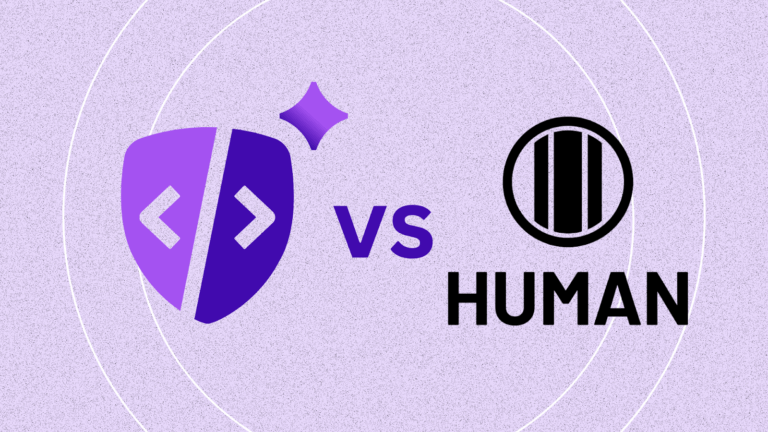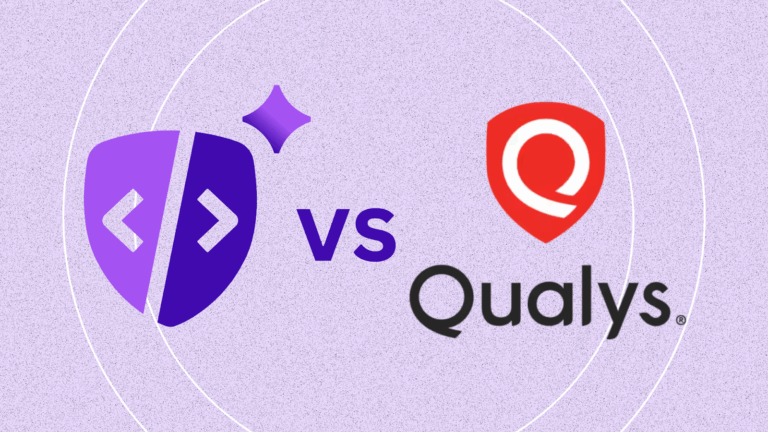TL;DR
- What it is: The General Data Protection Regulation (GDPR) is the EU’s comprehensive data privacy law protecting individuals’ personal data.
- Why it matters: It applies to any company worldwide that collects or processes data on EU residents—regardless of location.
- Who it applies to: E-commerce, SaaS, media, healthcare, finance, ad tech, and any site using cookies, scripts, or trackers that monitor EU users.
- Common pitfalls:
- Relying solely on cookie banners for consent (Article 6)
- Failing to map or control third-party data access (Articles 13–15, 30)
- No audit trail or proof of data protection by design (Articles 25, 28)
- How Feroot helps: Feroot gives teams visibility and control over client-side scripts—detecting unauthorized behavior, enabling real-time alerts, and generating compliance-ready reports.
Does GDPR Apply to My Website—Even If I Don’t Operate in the EU?
Yes. If your website is accessible in the EU and collects any user data—through forms, cookies, session recordings, pixels, or embedded scripts—then GDPR likely applies.
But compliance isn’t as simple as publishing a privacy policy or showing a cookie banner.
Modern web apps expose personal data through invisible front-end technologies like third-party JavaScript, ad tags, tag managers, and behavioral trackers. These tools can access personal data (like IP addresses, session activity, or geolocation) before users explicitly give consent.
This is where many organizations fall short—and where Feroot provides critical visibility, enforcement, and proof of compliance.
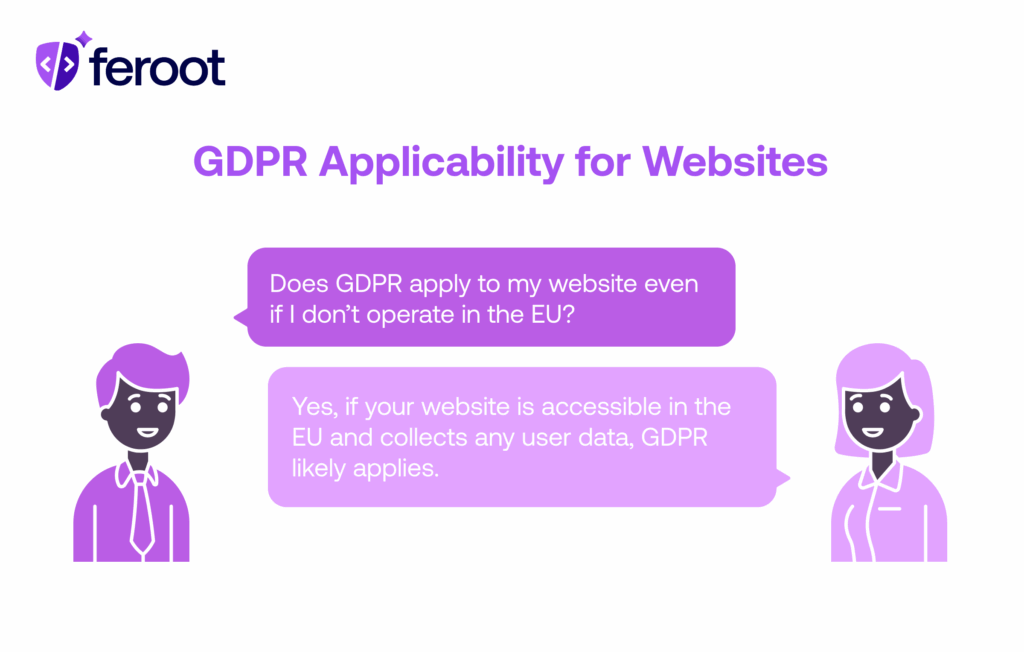
What Is the GDPR?
The General Data Protection Regulation (GDPR) is the EU’s flagship privacy law that came into effect in May 2018. It governs how organizations collect, use, store, and transfer personal data of individuals within the European Union.
Key details:
- Regulatory bodies: European Data Protection Board (EDPB), plus individual national DPAs (e.g., CNIL, ICO)
- Territorial scope: Global—applies to any organization targeting or tracking EU users
- Sectors affected: Retail, software, healthcare, financial services, advertising, media, and more
GDPR compliance requires more than back-end controls. It mandates full visibility into all data processing—including what happens inside the browser.
Which GDPR Articles Does Feroot Support?
Feroot helps address the following critical GDPR articles:
- Article 6 – Lawfulness of processing: Organizations must have a legal basis—like explicit consent—for collecting personal data.
- Articles 13–15 – Transparency & data subject rights: Users must be informed about what data is collected, how it’s used, and with whom it’s shared.
- Article 25 – Data protection by design and by default: Privacy and security must be built into your systems—including the client side.
- Article 28 – Processor accountability: You must monitor and control what third-party processors (scripts, services) do with your user data.
- Article 30 – Records of processing activities: Organizations must document what data is collected, where it flows, and how it’s protected.
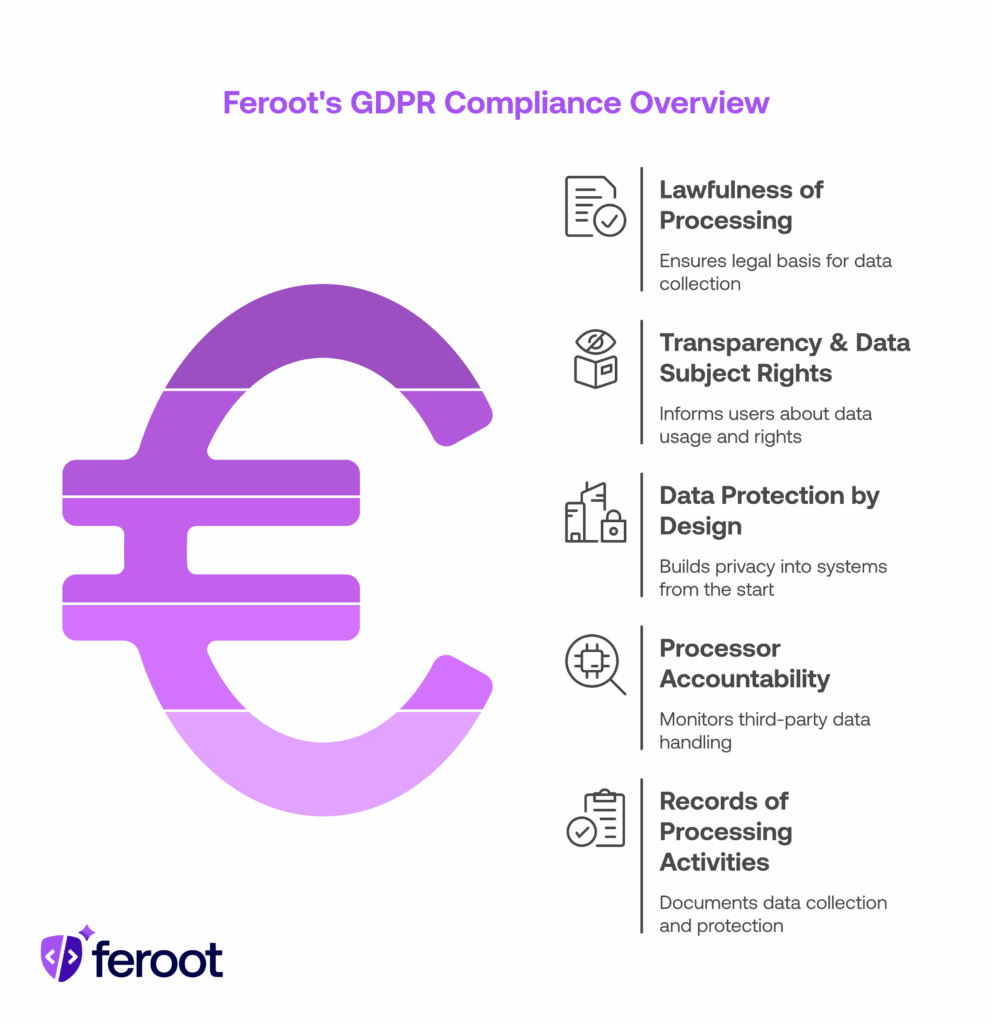
Where Companies Fail GDPR Compliance (Especially on the Front End)
Despite spending millions on privacy programs, many companies still fail GDPR audits and investigations. Common points of failure include:
- Uncontrolled third-party access: Pixels, analytics tags, and chatbots often collect data without proper consent or controls.
- Invisible data transfers: JavaScript libraries may send personal data to non-EU servers (e.g., U.S. or China) without safeguards.
- No real audit trail: Without browser-level monitoring, teams can’t prove what data was accessed, by whom, and when.
- Static compliance models: Cookie banners don’t prevent data access—they just ask for permission. They don’t enforce boundaries.
These failures have led to high-profile fines across industries—from social media platforms to local retailers.
How Feroot Helps Automate GDPR Compliance
Feroot gives security, privacy, and compliance teams the tools to enforce and prove GDPR compliance on the client side. Here’s how Feroot maps to each key article:
Article 6 – Lawfulness of Processing
Consent banners are only part of the equation. Feroot shows whether scripts are collecting data before consent is given.
With Feroot:
- Detect and block unauthorized scripts that start tracking too early
- Monitor if consent status is respected across first- and third-party scripts
- Prevent “shadow tracking” by embedded third-party tools
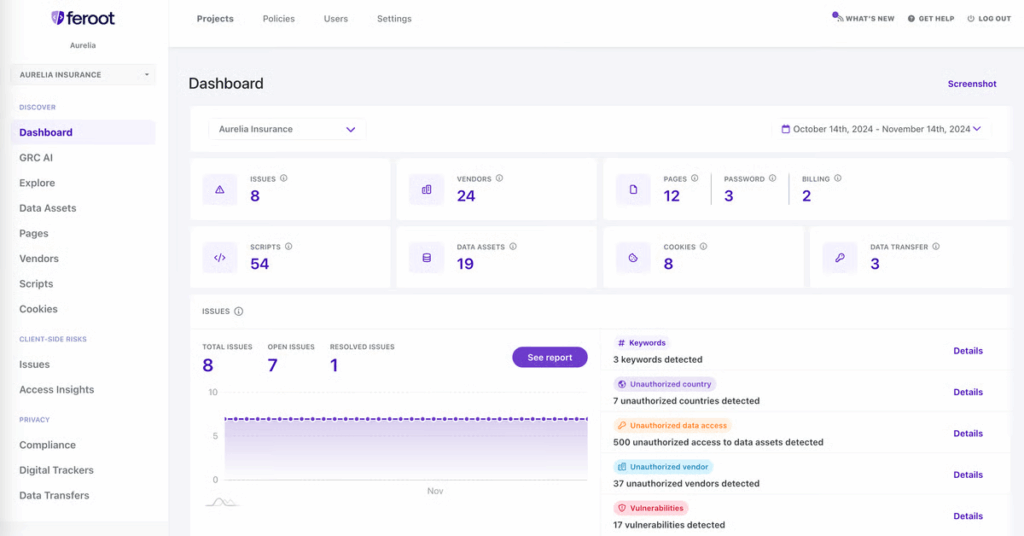
Articles 13–15 – Transparency and Data Subject Rights
These articles require you to inform users about what data you collect and respond to access requests. But how can you document what scripts are doing on the page?
With Feroot:
- See what personal data each script collects (IP, geolocation, behavior)
- Map outbound data flows to third-party domains
- Document access by processors and subprocessors
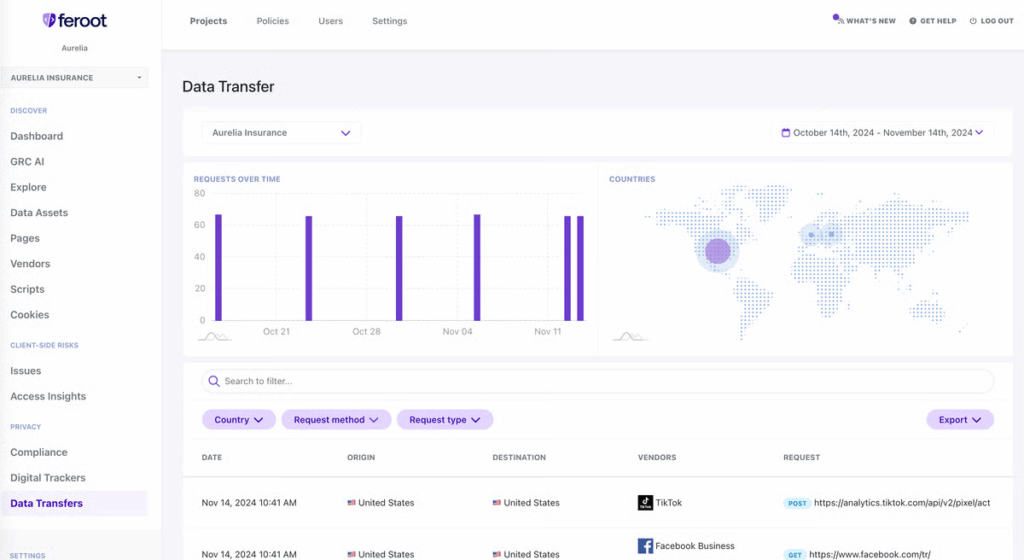
This provides the transparency needed to respond accurately to data subject requests and privacy inquiries.
Article 25 – Data Protection by Design and Default
This article mandates proactive security and privacy—not just reactive measures.
With Feroot:
- Map every client-side script and resource
- Continuously monitor for unexpected changes
- Enforce access controls to minimize data exposure
Feroot makes privacy a built-in, enforceable control at the browser level—not an afterthought.
Article 28 – Processor Oversight and Accountability
You are responsible for what your third-party scripts and services do with user data—even if they’re embedded via tag managers.
With Feroot:
- Automatically detect all third-party processors running in your app
- Monitor and flag risky behaviors (e.g., data access outside declared purposes)
- Block or isolate scripts violating your data sharing agreements
This keeps your data processor ecosystem GDPR-compliant.
Article 30 – Records of Processing Activities
GDPR requires detailed documentation of your data handling practices—including where personal data flows on your website.
With Feroot:
- Generate audit logs showing script activity over time
- Provide visual records of data access and flows
- Maintain a living inventory of scripts, trackers, and their behaviors

This gives DPOs and auditors a defensible record of processing operations—at the script level
FAQ
What are the penalties for noncompliance with GDPR?
Organizations can face fines of up to €20 million or 4% of global annual revenue, whichever is higher. Many fines are issued for failures to control third-party access or collect valid consent.
Does GDPR apply to third-party scripts like GA4 or Meta Pixel?
Yes. Even if the data is collected by a third-party, you are the data controller if it’s on your website. That means you’re responsible for what those scripts do.
How does Feroot help with Data Protection Impact Assessments (DPIAs)?
Feroot shows how personal data is accessed and shared in real time. Its reports make DPIAs faster, clearer, and easier to document—especially for high-risk web apps.
Can I use Feroot to stop data collection until a user consents?
Yes. Feroot detects script behavior in real time and can alert you when scripts begin data collection before consent is granted—so you can take action or block as needed.
How does Feroot differ from traditional privacy tools?
Traditional tools focus on backend infrastructure and consent capture. Feroot focuses on the browser, where scripts actually run and access data—offering protection no other platform provides.
Conclusion
GDPR enforcement has moved beyond privacy policies and checkbox consent. Regulators now expect proof that organizations monitor how scripts and processors handle personal data on the client side.
By visualizing how scripts operate, blocking unauthorized access, and generating compliance-ready audit trails, Feroot gives you total visibility and control—where it matters most.
Explore the rest of our “Beyond PCI and HIPAA” blog series to learn how Feroot supports compliance with other global regulations.
